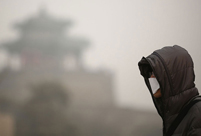 'Jin' named the word of the year by cross-strait netizens
'Jin' named the word of the year by cross-strait netizens Chinese scientific expedition goes to build new Antarctica station
Chinese scientific expedition goes to build new Antarctica station
 Chinese naval escort fleet conducts replenishment in Indian Ocean
Chinese naval escort fleet conducts replenishment in Indian Ocean 17th joint patrol of Mekong River to start
17th joint patrol of Mekong River to start China's moon rover, lander photograph each other
China's moon rover, lander photograph each other Teaming up against polluters
Teaming up against polluters
LANZHOU, Jan. 1 -- Lanzhou, capital of northwest China's Gansu Province, on Wednesday implemented a tough smoking ban in specified public places aimed at combating "indoor haze harm."
The legislation clearly specifies "non-smoking" indoor areas, including medical institutions, schools, government office buildings, public dining places, and public transport carriers.
It also clarifies the legal responsibilities of individuals, managers and tobacco sellers in these places.
"The legislation empowers the manager of a non-smoking place to order people smoking indoors to go outside," said Zhang Fushou, director with the legislative affairs commission of Lanzhou Municipal People's Congress Committee.
Managers and staff in these public places can complain to supervision authorities if they fail to discourage smokers, who could be fined from 50 to 200 yuan (about 8.25 to 33.02 U.S. dollars).
Managers of such places could also receive a warning or economic penalty if they do not fulfill their responsibilities in discouraging indoor smoking. The penalty ceiling is 10,000 yuan.
Lanzhou's smoking ban is the toughest among related rules and regulations in China's western regions, said Yang Jie, a tobacco control officer with the Chinese Center for Diseases Control and Prevention (CDC).
The ban puts the city on the same level as first-tier cities in smoking controls and features smoking bans in government buildings and public transport carriers, Yang said.
The Communist Party of China Central Committee and the State Council issued a circular in late December to ask officials to "take the lead" in adhering to smoking bans in public spaces.
Officials are not allowed to smoke in schools, hospitals, sports venues, public transport vehicles, or any other venues where smoking is banned, the circular notes.
Chinese people are well aware of the dangers of outdoor haze, but in fact, indoor haze is more hazardous, said Gan Quan, a senior project officer with the International Union Against Tuberculosis and Lung Disease.
In a 35-square-meter room, the density of PM2.5 surges to 800 micrograms per cubic meter after one cigarette is lit indoors, said Gan, quoting an experiment conducted by the Chinese Center for Disease Control and Prevention (China CDC). The PM2.5 readings soar to 1,000 micrograms per cubic meter after two cigarettes, and 1,800 micrograms per cubic meter after three cigarettes, said Gan.
"Staff are exposed to about a 30 percent higher risk of lung cancer if their colleagues smoke indoors in workplaces."
Xie Wei, an official with the Lanzhou Health Bureau and the city's tobacco control office, said that the public places listed as non-smoking in the legislation are the worst-hit areas for secondhand smoke.
Smoke-free laws for public places are the most effective way to protect public health according to international experience, he said.
The Lanzhou tobacco control office is busy training smoking control inspectors and conducting public education on smoking controls.
As the world's largest cigarette producer and consumer, China has over 300 million smokers and at least 740 million nonsmokers whose health is frequently put at risk by secondhand smoke.
By the end of 2013, nine cities in China had implemented smoking bans in public places. Starting on Jan. 1, 2014, more cities, including Lanzhou, Shenzhen, and Tangshan, also implemented similar rules and regulations.
China's Legislative Affairs Office of the State Council listed the smoking ban regulation in its draft plan in 2013, marking progress for a legislative process on the national-level, said Yang.
 Commemorate 120th birth anniversary of Mao Zedong
Commemorate 120th birth anniversary of Mao Zedong Female soldiers of PLA Marine Corps in training
Female soldiers of PLA Marine Corps in training Chinese cities to have a very grey Christmas as smog persists
Chinese cities to have a very grey Christmas as smog persists China and U.S. - the national image in each other’s eyes
China and U.S. - the national image in each other’s eyes The Liaoning's combat capability tested in sea trial
The Liaoning's combat capability tested in sea trial Chinese pole dancing team show their moves in snow
Chinese pole dancing team show their moves in snow Rime scenery in Mount Huangshan
Rime scenery in Mount Huangshan Ronnie O'Sullivan: My children mean the world to me
Ronnie O'Sullivan: My children mean the world to me Shopping in Hong Kong: a different picture
Shopping in Hong Kong: a different picture Yearender: Animals' life in 2013
Yearender: Animals' life in 2013 Hello 2014 - Chinese greet the New Year
Hello 2014 - Chinese greet the New Year Chocolate 'Terracotta Warriors' appear
Chocolate 'Terracotta Warriors' appear  Top 10 domestic news of 2013
Top 10 domestic news of 2013 Red crabs begin annual migrations in Australia
Red crabs begin annual migrations in Australia Artifacts retrieved from West Zhou Dynasty
Artifacts retrieved from West Zhou DynastyDay|Week|Month